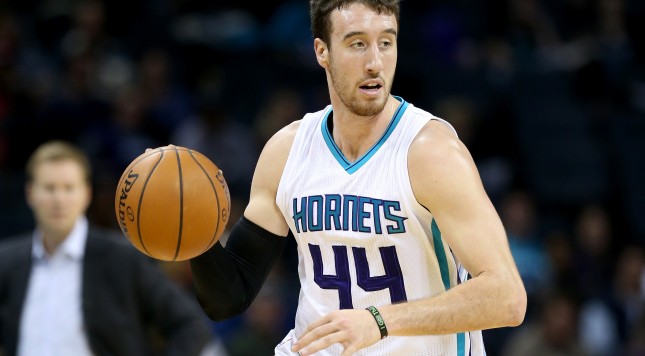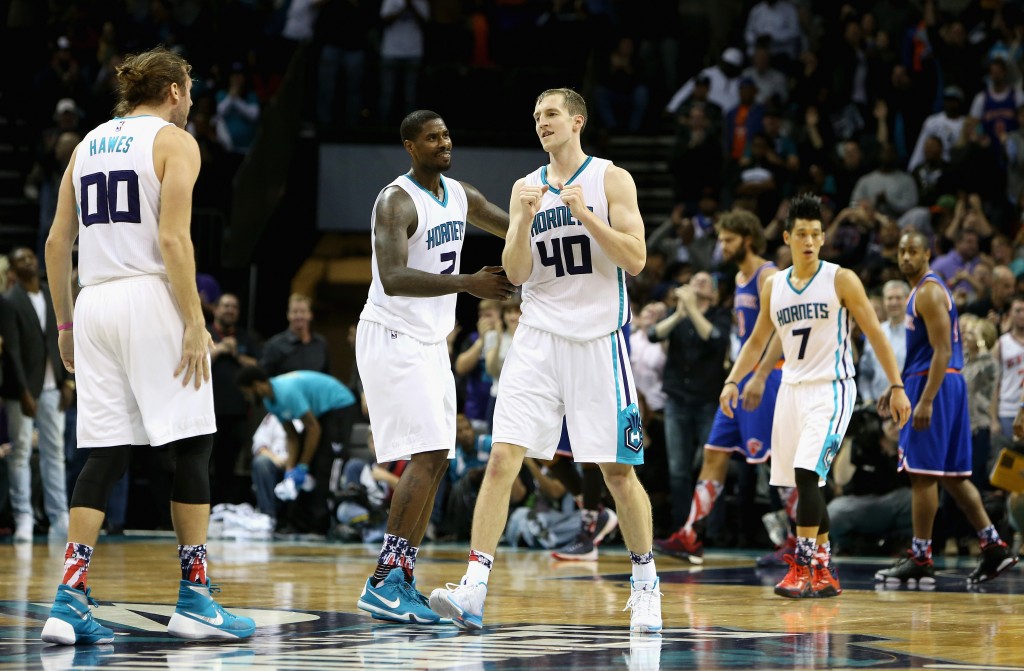The Hornets have won 10 of their last 14 games, inserting themselves into the suddenly deep Eastern Conference playoff picture after a preseason injury to Michael Kidd-Gilchrist turned many critics against them. What skeptics couldn’t anticipate was a swift change in offensive philosophy that would enable Charlotte to become one of the more adventurous shooting teams in the NBA.
Charlotte has developed a top-5 offense, scoring 104.3 points per 100 possessions, per NBA.com, while maintaining a 99.7 defensive rating against one of the league’s most taxing schedules. Early road wins against Dallas and Minnesota look better than before, as do losses at Miami and Atlanta, and Charlotte’s four recent losses were at San Antonio, single-digit games at New York and Chicago and a five-point loss against Cleveland. The tests continue to pile up for the Hornets: their next five games are against the Warriors (Wednesday), Bulls, Pistons, Heat and Grizzlies. To make matters more difficult, Al Jefferson strained his left calf against the Bucks on Sunday and will miss two to three weeks.
On the surface, losing Jefferson and his paint presence leaves the Hornets without a proven No. 1 option, but Jefferson hasn’t been the double-double factory at age 30 he was during his late-20s. He’s averaging 13.7 points on 12.4 FGA, his lowest shooting figures since he was a Celtic. His minutes are down in a contract year — head coach Steve Clifford is disengaging him from the offense, making room for a new era of Hornets basketball. Charlotte hung on to beat Milwaukee with a souped up version of their new-look offense — cashing 15 of 31 3-pointers (48.4 percent) and crushing the Bucks’ off the pine, 35-14.
The Hornets were down, 18-10, in the first quarter around the time Jefferson came limping out. The frontcourt rotation of Cody Zeller, Frank Kaminsky and Spencer Hawes shuffled the board — stimulating on- and off-ball movement, and creating easy shots around the perimeter. Kemba Walker, a player whose game is predicated on dribble penetration, had a wealth of open lanes. Kaminsky was running baseline, catching ball reversals with his back to the basket, and swinging to cutters and spot-up shooters. Charlotte (18-for-22) owned Milwaukee (8-for-14) at the charity stripe despite giving up a massive amount of size in the matchup; the Hornets beat the Bucks down the floor, set up their swing offense, and their agile bigs created inside-out looks for Jeremy Lamb and Nic Batum.
Yes, Milwaukee caught up in the second half behind 44 points in the paint, to Charlotte’s 14. Giannis Antetokounmpo posted Lamb and Monroe sent Zeller to the cleaners on back-to-back possessions late in the fourth to tie the game at 80. It wasn’t enough. Following a big-time Batum 3 coming off a back screen, Walker split the defense on a Zeller high screen, catching Monroe in deep water, and driving for the game-delivering bucket.
The Hornets are winning, right now, with a collection of afterthoughts and castaways playing fun, electric basketball. Losing Jefferson for 8-10 games ups the ante for Charlotte. Can Clifford navigate a tough December schedule without one of his best players? Can Charlotte keep climbing the East with Zeller, Kaminsky and Hawes as its rotational bigs?
The Hornets have lifted their offensive rating by more than seven points over last season. The ball zips around without trading sides — the Hornets are second to the immaculate Warriors in assist-to-turnover ratio — and the team is knocking down an uptick of open shots after years of working a crowded floor. Charlotte is seventh in the NBA in eFG% and true-shooting percentage. The new offense is 3-point heavy, residing in the top 5 in long-range attempts, but the Hornets are shooting 35.9 percent.
Charlotte complements its new offense by keeping opponents off the line (opponents’ FTA rate: 22.8) and halting transition opportunities. No team in the NBA eschews offensive rebounds more in order to get back, and the Hornets’ opponents are toward the bottom of the league in points off turnovers and fast breaks. It should also be noted the team is typically excellent at limiting points in the paint — the team’s interior trouble against Milwaukee and Greg Monroe may be an aberration. Clifford has had Charlotte playing conservative, drop back defense for quite some time. Losing Jefferson doesn’t change anything for Charlotte defensively, and Clifford demands a team-wide effort to force contested jumpers and keep invaders from the rim:
Detractors will be quick to point out playing Zeller, Kaminsky and Hawes the bulk of the frontcourt minutes is death for a defense. Again, Jefferson has been a sieve against the pick-and-roll his entire career, and Clifford has crafted above-average (or better) units from this core throughout his tenure. What these three players punt in terms of girth, they make up for in height, and what they lack in traditional speed they gain back in effort. Jefferson’s defensive rebounding percentage (21.7) wasn’t light years above Hawes (20.5) and Zeller (19.3) during the young season, and Charlotte has been the No. 2 defensive rebounding team in the NBA, per NBA.com.
Zeller even offers Charlotte an 8.3 OffReg%, giving him the nod as the team’s best rebounder through 17 games, and he’s flatly quicker than Jefferson in any respect. Zeller will hedge hard and gun for the steal when he thinks he has the guard trapped. He even tried it against LeBron on Friday, and promptly picked up the foul. Zeller isn’t dangerously smaller than most bigs, and against the Monroe types he can hold his own by working harder — beating his man to the spot, anticipating entry passes, correctly timing pokes and prods:
Kaminsky, a slender rookie with great instincts, is not of the same caliber of Zeller/Hawes on the glass or guarding the interior. He’s a power forward right now defensively. Against the majority of teams in the league, however, Kaminsky won’t get mowed over at the 4. He’s a very active close out defender, and Kaminsky has grabbed 22.2 percent of steals and 21.2 percent of blocks when he’s on the floor this season:
Offensively is where Kaminsky has really opened eyes. He’s one of seven bigs with a 10 percent assist and 3PM rate. His constant motion off ball scrambles the defense and his jumper create open spaces all over the floor:
Kaminsky has had great chemistry with Lamb. In 165 minutes, the Hornets are outscoring opponents by nine points per 100 possessions, per NBA.com, with a borderline top-5 assist ratio of 17.8. In semi-transition, Kaminsky will flag a Lamb pick-and-roll, freeing Lamb for an open look:
Lamb is cashing 58.8 percent of his mid-range shots and shooting 35.2 percent on 3s above the break, as he’s been enjoying a spaced floor with an uptick in usage in Charlotte. Where Lamb has flown off the charts is in the restricted area, where he has made 33 of 45 shots. Watch Lamb fly off a Kaminsky brush screen, catch and make his run to the hoop with LeBron Effing James on his trail:
Kaminsky reads the floor very well, something his harshest critics in June failed to account for when predicting he’d fail to make the leap to the pros, or live up to the infamous “Godfather offer” the Celtics made for the No. 9 pick and Justice Winslow. Kaminsky has his weak spots. He’s very bad in the paint — outside the restricted area (4 for 14, 28.6), as well as inside, where he is shooting 53.8 percent, 54th out of 58 centers with 25 attempts. Again, he’s not a real center. He’s 8 for 21 on 3s above break (38.1) and has attempted only two corner 3s, a number that should increase with more playing time and regularity:
I’ll preface this by admitting it’s a small sample size, but one of the more intriguing units on the young season for Charlotte has been a bench-hybrid group featuring Jeremy Lin, Lamb, Marvin Williams, Kaminsky and Hawes. In 48 minutes, this spongy defensive group with five adequate shooters has a 34 NetRtg with a 59 true-shooting percentage and 68.9 assist percentage.
Yes, this is mostly against bench units, but throw Kemba Walker in for Lin, rotate Batum and Zeller in and out, and this can be the base for an eight-man rotation in a hyper-drive version of what Charlotte is already doing. Work faster, open the floor for drive-and-kicks and high volume shooting from deep, all while keeping up the team’s conservative defensive principles. When Walker and Kaminsky share the floor, the team has a 104.2 OffRtg and 98 DefRtg in 129 minutes, running at 101 possessions per 48 minutes. These lineups have a propensity to zoom and find lanes to the basket, collapsing the defense and netting high quality shots:
Cleveland, a much more accomplished team than Charlotte, surrendered multiple layups under the hoop simply because it couldn’t wrap its head around all of the shooting:
Charlotte will deal with growing pains (reminder: Golden State on Wednesday) as teams catch up to the changes. However, their new style of play isn’t a cheap trick or gimmick. Movement on- and off-ball, passing, efficient shooting — these are timeless elements of the game. Years of peculiar team building have surprisingly yielded the most equipped Steve Clifford team to handle the modern game. Let the people eat cake — the Hornets are fun to watch again.


